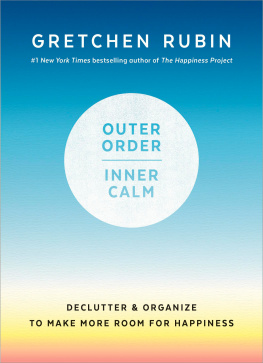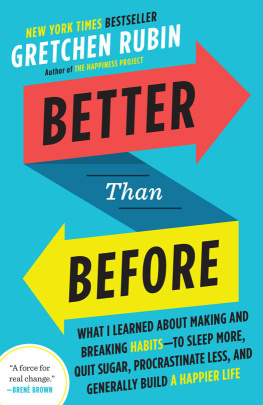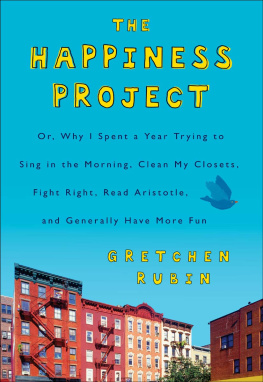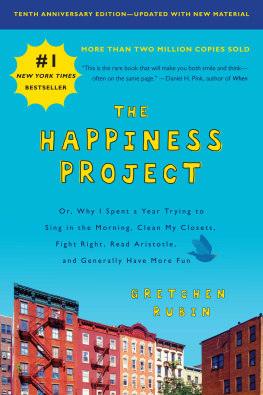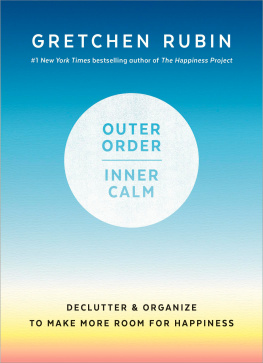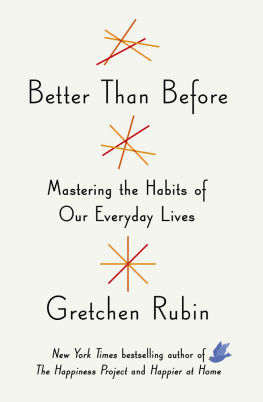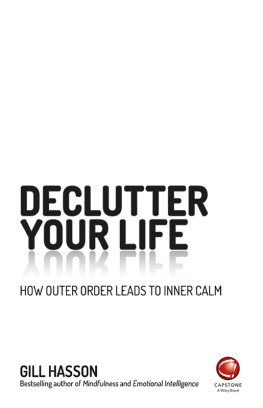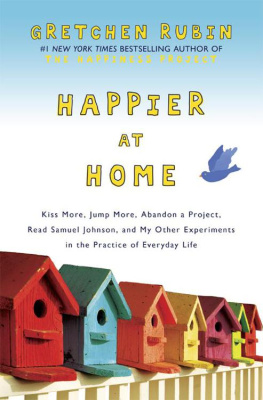Contents
Landmarks
Print Page List
ACKNOWLEDGMENTS
Thanks, as always, to my brilliant agent, Christy Fletcher.
Thanks to Crystal Ellefsen, whose remarkable insights and hard work allow me to put my words out into the world every day.
Thanks to Jayme Johnson and Jody Matchett for their indispensable help.
Thanks to my wonderful publishing team: Christina Foxley, Diana Baroni, Sarah Breivogel, Aaron Wehner, Danielle Deschenes, and Marysarah Quinn, and special thanks to my terrific editor, Mary Reynics.
Thanks to my readers, listeners, and viewers. Ive gained so much from your insights, observations, and questions about outer order and inner calm.
A heartfelt thanks to my beloved family and friends, who are the beneficiariesand the innocent bystandersof my quest for outer order.
And finally, special thanks to my sister, Elizabeth, who has given me so many hours of happiness by graciously allowing me to clear her clutter.
TOP TEN TIPS FOR CREATING OUTER ORDER
Everyone has a different list, of course. From my observations, these ten tips are the ones people find most useful:
1 | Make your bed.
2 | Follow the one-minute ruleanything you can do in less than one minute, do without delay.
3 | Have a weekly power hourmake a list of tasks youd like to accomplish and spend one hour, once a week, tackling the items on the list.
4 | Make it fun to get the job done.
5 | Dont let yourself fall into empty.
6 | Dont put things down, put them away.
7 | Dont stockpile; that is, dont store more of an item than you can realistically use.
8 | Keep mementos that are small in size and few in number.
9 | Keep things organized, but not overly organized.
10 | If you cant find something, clean up.
SUGGESTIONS FOR FURTHER READING
If youd like to read more about creating outer order, you might enjoy these books.
THE HAPPINESS PROJECT by Gretchen Rubin
One rainy afternoon, while riding a city bus, I asked myself, What do I want from life, anyway? I thought, I want to be happyyet I realized that I didnt spend any time thinking about my happiness. In a flash, I decided to dedicate a year to a happiness project. I spent twelve months test-driving the wisdom of the ages, current scientific research, and lessons from popular culture about how to be happier. Each month, using myself as a guinea pig, I tested a new set of resolutions around different themes, such as vitality, leisure, and marriage.
HAPPIER AT HOME by Gretchen Rubin
This book is all aboutyou guessed ithow to be happier at home.
Starting in September (the other January), I dedicated a school yearSeptember through Mayto making my home a place of greater simplicity, comfort, and love. Each month, I tackled a different theme, such as possessions, time, and neighborhood, by experimenting with concrete, manageable resolutions aimed at making my home a happier place.
BETTER THAN BEFORE by Gretchen Rubin
When were trying to create and maintain outer order, we often try to improve our habits. But how exactly do we change our habits?
Many experts offer one-size-fits-all solutionsbut, alas, theres no magic formula that works for everyone. The secret is to pinpoint the specific strategies that will work for each of us. From finding the right time to begin a new habit, to recognizing the counterintuitive risks of reward, to using the pleasure of treats to strengthen our good habits, I identify the twenty-one strategies that will allow every reader to find an effective, individual fit.
A PATTERN LANGUAGE by Christopher Alexander et al.
This strange, brilliant book changed the way I see the world. It uses architecture, sociology, psychology, and anthropology to describe the most satisfying designs of towns, buildings, offices, and homes, by setting forth an archetypal language of 253 patterns.
Instead of discussing familiar architectural styles and design decisions, it focuses on patterns such as the Front Door Bench, Child Caves, Sleeping to the East, Staircase as Stage, Cascade of Roofs, and Half-Hidden Garden. My favorite? Secret Place. As I explain in Happier at Home , I was inspired to create several secret places in our apartment. I couldnt stop with just one.
THE LIFE-CHANGING MAGIC OF TIDYING UP by Marie Kondo
This book made me jump out of my chair and start clearing clutter.
I dont believe that theres one right way to clear clutter; as I explore here, and in my other books, I believe that we all must find the way to happiness and good habits thats right for us. Kondo argues for one best way, the KonMari way. Nevertheless, I did find the book both engaging and helpful.
ORGANIZING FROM THE INSIDE OUT by Julia Morgenstern
This book is helpful, realistic, and concrete.
Julie Morgenstern emphasizes the reasons for clutter. The fact is, clutter isnt just a matter of not having enough closet space or not sorting the mail every day. She addresses the fact that we hold on to possessions for different reasons, and once we acknowledge that aspect of clutter, were able to clear clutter far more effectively, by setting up systems that are suited to our own nature.
ABOUT THE AUTHOR
Gretchen Rubin is one of the most thought-provoking and influential writers on the linked subjects of happiness, habits, and human nature. Shes the author of many books, including the blockbuster bestsellers The Happiness Project , Better Than Before, The Four Tendencies , and Happier at Home . She has an enormous following, in print and online, and her books have sold more than three million copies worldwide, in thirty languages. On her popular podcast Happier with Gretchen Rubin , she discusses happiness and good habits with her sister, Elizabeth Craft (Elizabeth is very messy), and on her site, gretchenrubin.com, she regularly reports on her adventures in pursuit of happiness. A graduate of Yale and Yale Law School, Gretchen Rubin was clerking for Supreme Court Justice Sandra Day OConnor when she realized she wanted to be a writer. She lives in New York City with her husband and two daughters.
CONCLUSION
The Fulfillment of Inner Calm
Outer order is a challenge to impose and its a chore to maintain. Nevertheless, for most of us, its worth the effort.
Why ? Why does outer order contribute to inner calm, and why does inner calm make us happier?
To answer these questions, its helpful to think about the elements of a happy life: feeling good, feeling bad, and feeling right , in an atmosphere of growth .
Outer order helps us to feel good: we gain a sense of rest, of spaciousness, of organization, of energy.
Outer order helps us no longer to feel bad: we get relief from irritation, guilt, frustration, hurry, and resentment of other people.
Outer order helps us to feel right: were able to keep our attention, time, energy, and money trained on the tasks, people, places, activities, and values that matter most to us.
Outer order helps us to create an atmosphere of growth: we make visible improvements in our surroundings, in ways that benefit everyone who enters that place, with room to expand, with a sense of renewal.
The irony is that just as outer order contributes to inner calm, inner calm contributes to outer order. When we feel serene, energetic, and focused, thats when it becomes easier to keep our surroundings in good order. Its a virtuous cycle.
For meand for many other peoplewhen its easier for me to hang up my coat, it becomes easier to go to the gym. A clear desk helps me to write an unpleasant email with less waffling. Change fosters change.

